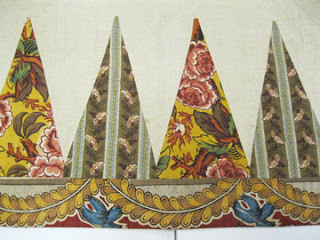Hewson panel
from Andover Fabrics
The British burned the Capitol Building
There's already one quilt challenge for this anniversary.
The Great Lakes Seaway Trail of NY and PA invite quilters to make authentic War of 1812-era reproduction-style quilts for the not-for-profit byway travel organization’s 2012 quilt show and competition. They ask for is "cot to coffin" size and they are encouraging authentic reproduction quilts of fabrics, including cotton, linen, silk, wool and linsey-woolsey; colors made with dyes available in that era; and patterns true to the 1812 .
Click here for more information:
http://www.seawaytrail.com/quilting.html
And follow the blog about the contest.
http://1812quiltchallenge.blogspot.com/
See Moda's page at their Giving Back web address and then click on Great Lakes Seaway over on the right.
http://www.unitednotions.com/un_main.nsf/giving-back!OpenPage
Lucky for fans of early quilts there are several reproduction lines in the works. Moda and I have a collection of chintzes and dress-scale prints called Lately Arrived from London that will be in quilt shops in September.
The Little Molly from Lately Arrived from London
The look is 1780-1820
Andover is working with the Winterthur Museum to print reproductions of the famous John Hewson panel that is featured in several quilts dating to the era. See the featured panel with the vase at the top.
Hewson stripe from Andover
View more examples of the prints in that line at the Busy Thimble blog
Margo Krager has reproductions of several European panels that were popular with Americans in the early 19th century. Her Reproduction Fabrics webstore is laser-printing some of the classics like the Trophy of Arms below.
See more by clicking here
The American Quilt Study Group is printing two reproductions as a fundraiser, a stripe and a floral. These will be real collector's items.
Click here to find out how to order
And Rose Studios has a panel in a line called Manchester Glory.
Panels are hard to find. Early 19th century prints of any kind are hard to find. Let's hope these reproductions all sell so well that we'll start a fad for plum-colored chintzes and panels of fruit.
The Wellington Victory panel
from a quilt belonging to the Victoria & Albert Museum in London
See quilts with panels by clicking on these links to museum collections:
Two from the Winterthur Museum
And one from the International Quilt Study Center and Museum
2008.040.0060
And check this blog post at the Great Lakes Seaway blog to see more links and period quilts































